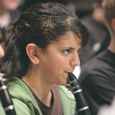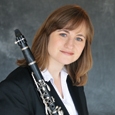Full altissimo fingering chart
High school and college-level clarinetists may be unfamiliar with the standard fingerings for altissimo notes, let alone the staggering number of useful variations and possibilities in the highest register of that instrument. Students tend to avoid these notes altogether because standard fingering charts often leave off at C6, and many students fear them unnecessarily because the fingerings are somewhat less obvious and a little more complicated than those in lower registers. I developed a fingering chart consisting of only the fingerings I found to be the most usable and reasonably in tune, showing the most common or standard fingering first, with alternates following.
When playing in the clarinet’s altissimo register, the main considerations are the ease of getting to the fingering, the resistance level of the note (how easily it speaks), and pitch. All can be dependent upon which notes the player is coming from and going to, as well as the individual instrument and mouthpiece and reed setup. It is important to note that there is no right or wrong fingering choice; I always emphasize to students that a fingering chart’s main use is to show available options so a good choice can be made.
This excerpt is measures 25-30 of No. 19 from 32 Etudes by Rose.
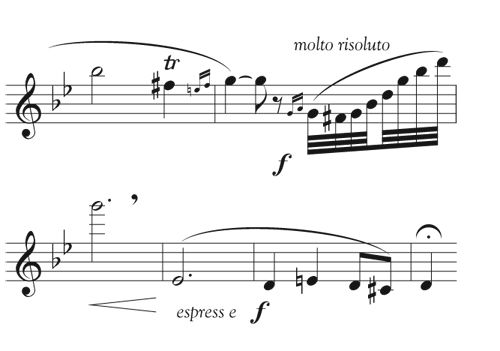
G6 presents a dizzying array of choices. In addition to the eight fingering options shown, there are several additional ways to produce this note on the clarinet. When considering the ease of getting to the G6 in the third mesaure of the example, I would eliminate choices two and seven, which are awkward to get to from D6. Because this passage is marked forte and molto risoluto, it would be important to choose a high G with a resistance level that is neither too light nor free-blowing. Usually choices that include more fingers are more resistant, so at this point I would lean toward options one, four, five, or six. Pitch will likely determine the final choice. I would not want to be sharp on this note, so a good choice for me is option four. It is a solid fingering that I can get to easily, play strong and loud, and be in tune. Other players might choose one, five, or six if any of these was more in tune for them.
Fingerings for G6

There are a number of altissimo passages in the orchestral excerpts that a college-level player might encounter.
The high Gs in the Trio section from Beethoven’s Eighth Symphony, in contrast to the previous excerpt, should be played piano, and with exceptional ease and grace. For this reason, I choose a less resistant fingering for the G that appears below. My favorite is option 3, which I have come to call Easy G because there are so few fingers involved.
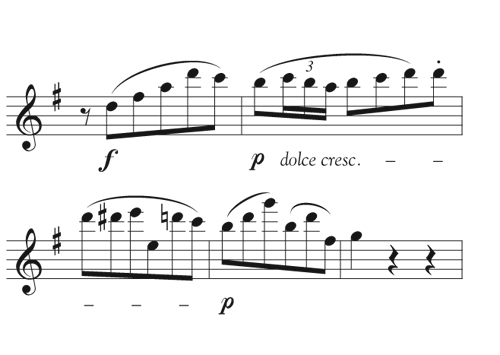
For the final high G in this same section, I prefer a fingering that comes out easily, but is sturdy enough to never squeak. The standard fingering is best here.
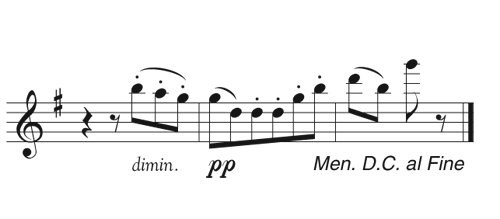
I vividly remember having quite a laugh with some college friends as we experimented with several possible fingerings for the repeated high Ds in Rimsky-Korsakoff’s Capriccio Espagnol. The standard fingering for D6 is somewhat awkward when moving to or from C6, so it is quite tempting to use an option like the third or fourth fingering in the list. Unfortunately, these options range from slightly to extremely flat at the requisite forte dynamic. Because the repeated motion from C to D is the main motive of this excerpt, the whole-step interval is prominent and should be properly spaced. I recommend staying with the standard fingering on this one.

Fingerings for D6

For daring souls who want to attempt the Variazione in modo di Scherzo per Clarinetto on A or Bb clarinet in Ginastera’s Variations Concertantes, I have included fingerings for the highest C# and D in the range, notes that appear very rarely in the repertoire but that are possible to produce. In the Bb version, the highest note is a C#7, and on the A it is a D7.
In a passage such as this, the approach to the high note becomes of great importance. The fingering choices should lead comfortably and smoothly from one to another and be of a similar resistance, or the high note will not speak. I write numbers above the altissimo notes referring to which choice on my fingering chart is the best to use. In the Bb version below, it is helpful to keep the same left hand pinky key down for all of the notes beginning on the G#.
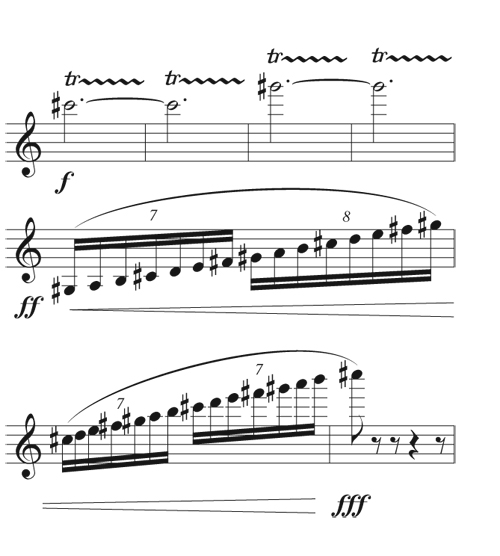
The G#6 I chose is the sixth option on my chart. For A6 I use the second, B6 the first, and C#7 the second.
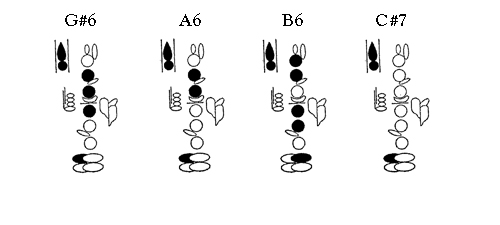
A frequent problem for band directors is what to do when several players in the section, or even the entire section, are playing altissimo notes together. Many of the notes in the altissimo register cause students to tense up, making the sound extremely loud, shrill, and strident. Composers sometimes choose high notes precisely because they want that effect, but it is also possible to play these notes softly and delicately. Anyone who has heard the top college or military bands knows it is possible for a clarinet section to play altissimo notes in tune without sounding overpoweringly strident, and it can produce an incredible sonority when done well.
Have every player start with the same fingering; this alone will probably help a lot. Beyond that, encourage students to approach high notes in a relaxed manner using warm air, a neutral throat, and an embouchure that is comfortable but not too tight. An excellent exercise is to have students ease into a high note by playing with air first, and gradually increase air speed until the note speaks. Ask them to remember how it felt at the point the note spoke and then start the note again at that point. It usually surprises them how easily high notes can speak, and that they do not need to force the air or the embouchure. Releasing any jaw pressure and avoiding excessive squeezing with the lips will help tremendously. It is best to relax and blow comfortably.
Extended passages in the altissimo can be a bit of a puzzle. I keep my fingering chart handy and research the best fingerings for navigating from one note to the next.
The full version of Stacey DiPaolo’s altissimo fingering chart:
page 1 pdf
page 2 pdf
page 3 pdf
page 4 pdf
Bibliography
Unpublished clarinet fingering chart by Philip Aaholm (Professor Emeritus of the University of Colorado at Boulder).
Modern Fingering System for Clarinet by Jay Arnold (New York: Shapiro, Bernstein & Co. Inc., 1953).
Yamaha Band Student, Book 2 by Sandy Feldstein and John O’Reilly (Alfred Publishing Co., 1989).
The Twentieth Century Clarinetist by Allen Sigel (New York: Franco Colombo, Inc., 1966).
Rubank Advanced Method, Clarinet Vol. I, Table of Fingerings for the Boehm System Clarinet by Himie Voxman and William Gower (Chicago: Rubank Incorporated, 1939).
